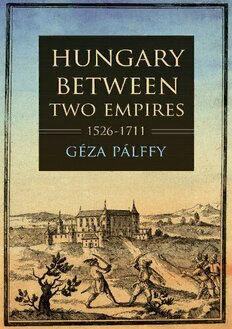
Hungary between two empires 1526-1711 PDF
Preview Hungary between two empires 1526-1711
HUNGARY BETWEEN TWO EMPIRES 1526–1711 STUDIES IN HUNGARIAN HISTORY László Borhi, editor Top Left: Ferdinand I of Habsburg, Hungarian- Bohemian king (1526–1564), Holy Roman emperor (1558–1564). Unknown painter, after Jan Cornelis Vermeyen, circa 1530 (Hungarian National Museum, Budapest). Top Right: Sultan Süleyman the Magnificent (1520–1566). Unknown painter, after Titian, sixteenth century (Hungarian National Museum, Budapest). Left: The Habsburg siege of Buda, 1541. Woodcut by Erhardt Schön, 1541 (Hungarian National Museum, Budapest). STUDIES IN HUNGARIAN HISTORY László Borhi, editor H U NG A RY BE T W E E N T WO E M PI R E S 152 6–17 1 1 Géza Pálffy Translated by David Robert Evans Indiana University Press This book is a publication of Indiana University Press Office of Scholarly Publishing Herman B Wells Library 350 1320 East 10th Street Bloomington, Indiana 47405 USA iupress . org This book was produced under the auspices of the Research Center for the Humanities of the Hungarian Academy of Sciences and with the support of the National Bank of Hungary. © 2021 by Géza Pálffy All rights reserved No part of this book may be reproduced or utilized in any form or by any means, electronic or mechanical, including photocopying and recording, or by any information storage and retrieval system, without permission in writing from the publisher. The paper used in this publication meets the minimum requirements of the American National Standard for Information Sciences—Permanence of Paper for Printed Library Materials, ANSI Z39.48-1992. Manufactured in the United States of America Cataloging information is available from the Library of Congress. ISBN 978-0-253-05463-0 (hardback) ISBN 978-0-253-05465-4 (paperback) ISBN 978-0-253-05464-7 (ebook) First printing 2021 Contents List of Figures ix List of Maps xi List of Tables xiii Acknowledgments xv Note on Terms and Names xvii List of Abbreviations xix Political and Military Chronology, 1526–1711 xxiii Introduction 1 I. Hungary after Mohács: A Century of Direction Seeking, 1526–1606 1. On the Frontier of Two Empires 7 2. Roads from Istanbul to Vienna: The Ottomans in Hungary 15 3. The Bumpy Road to Vienna: The Habsburgs and the Hungarians 29 4. The Road to Istanbul: The State of King John Szapolyai and His Son 43 5. On a Narrow Path: The Principality of Transylvania 53 6. Society Finds Its Way 61 7. The Economy and Its Roads to Europe 73 8. The Search for a New Home: Ethnic and Demographic Changes 83 9. Finding Faith: Hungary’s New Religion 91 10. Seeking a Language: A Cultural Golden Age 101 11. Looking in Vain for a Way Out: The Long Turkish War, 1591–1606 113 viii | Contents II. Decay and Rejuvenation: The Janus-Faced Seventeenth Century, 1606–1711 1. Peace or Civil War on the Border of the Two Empires? 125 2. New Ottoman Campaigns to Achieve an Old Goal 133 3. The Rise of the Hungarian Estates and the Break with Vienna 143 4. Transylvania Flourishes, Then Decays 155 5. Militarization and Self-Administration: Changes in Society 167 6. Economic Decline and Reorganization 177 7. Hungarian Populations Fall—Other Ethnic Groups Rise 187 8. The Revival of Catholicism—a Prolonged War of Religion 197 9. Half a Century of Cultural Progress—Half a Century of Military Crisis 207 10. A Country Liberated but Ravaged: The Long Turkish War, 1683–1699 219 11. Independence Movement and Civil War: The Rákóczi Uprising, 1703–1711 231 Glossary 241 List of Rulers and Highest Dignitaries 247 Select Bibliography (Monographs and Collected Studies) 253 Names and Nationalities Index 273 Place Index 279 Figures Frontispiece: Top Left: Ferdinand I of Habsburg, Hungarian-Bohemian king (1526–1564), Holy Roman emperor (1558–1564) Top Right: Sultan Süleyman the Magnificent (1520–1566) Left: The Habsburg siege of Buda, 1541 Chronology: Map of Hungary, after Wolfgang Lazius, 1579, xxii 1. Louis II of Jagiello, Hungarian-Bohemian king (1516–1526), 6 2. The Battle of Mohács, August 29, 1526, 10 3. Sultan Süleyman the Magnificent (1520–1566), 14 4. The Ottoman siege of Szigetvár, 1566, 21 5. Ferdinand I of Habsburg, Hungarian-Bohemian king (1526–1564), Holy Roman emperor (1558–1564), 28 6. The administration of the Kingdom of Hungary in the last third of the sixteenth century, 33 7. Pozsony (Pressburg; today Bratislava, Slovakia), the new capital of the Kingdom of Hungary in the sixteenth century, 37 8. John I Szapolyai, king of Hungary (1526–1540), 42 9. The Habsburg siege of Buda, 1541, 47 10. Stephen Báthory, prince of Transylvania (1571–1586), king of Poland (1576–1586), 52 11. Thaler of Sigismund Báthory, prince of Transylvania, with his portrait and family coat of arms, 1589, 58 12. Humanist Johannes Sambucus (1531–1584), 60 13. General Lazarus von Schwendi, border fortress captain György Thury, and Emperor Maximilian II, 67 14. Figure of Sebestyén Thököly (died 1607), from his charters of ennoblement in 1572, 72 15. The fortress city of Győr in the sixteenth century, 80 16. Miklós Zrínyi / Nikola Zrinski (1508–1566), 82 17. The Kostajnica border fortress on the river Una, 87 18. István Kis Szegedi (1505–1572), one of the leaders of Hungarian Protestantism, 90 19. Front page of the Vizsoly Bible, the first complete Bible translation into Hungarian, 1590, 95 20. Poet Bálint Balassi (1554–1594), 100 ix
